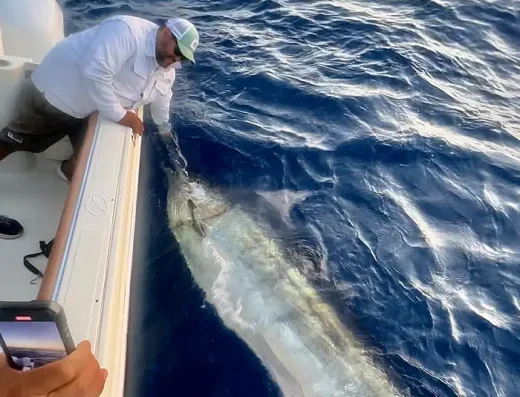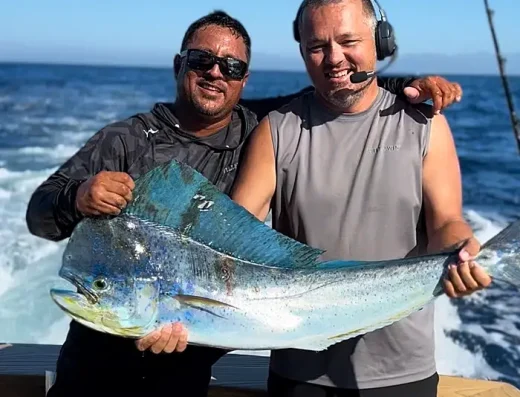Cabo San Lucas Fishing Charters
Cabo San Lucas fishing charters run straight from the marina into the Pacific Ocean and Sea of Cortez for marlin, tuna, dorado, wahoo, roosterfish, and snapper.
Top Rated Charters in Cabo San Lucas
TrustedFish connects anglers with proven local captains in Cabo San Lucas, Mexico —no commissions, no pay-to-play listings, no BS. Every charter on our platform is invite-only, vetted for skill, local knowledge, and reputation. If they’re listed, they’ve earned it.
Cabo San Lucas, MX Fishing Guide
Cabo San Lucas sits at the vCabo San Lucas sits at the very tip of Baja California Sur, where two oceans meet and the seafloor drops away within sight of shore. This unique setting makes it one of the most productive big-game destinations in the world. Charters launch from the Cabo San Lucas Marina, home to fleets ranging from simple pangas for half-day inshore trips to luxury sportfishers built for multi-day bluewater runs. With deep water less than 5 miles from the Arch at Land’s End, anglers are trolling in the big leagues within minutes of departure.
Half-day charters often focus on inshore fishing along the Pacific beaches or Sea of Cortez coastline, targeting roosterfish, sierra mackerel, snapper, and jacks. Full-day runs push offshore to legendary grounds like Golden Gate Bank, Gordo Banks, and the Finger Bank for marlin, tuna, dorado, and wahoo. During peak seasons, boats may run 20–30 miles, though trophy fish are often hooked much closer.
Seasonal shifts define the bite. Striped marlin are caught year-round, with spring bringing heavy concentrations. Summer delivers dorado, wahoo, and blue and black marlin, while yellowfin tuna action peaks in late summer and fall. Winter brings cooler water, which slows some pelagics but lights up inshore fishing for roosterfish, sierra, and snappers. Cabo is also home to major tournaments, with the Bisbee’s Black & Blue in October cementing its status as a marlin capital.
Techniques vary by target. Offshore charters troll skirted lures, rigged ballyhoo, and teasers for marlin, dorado, and sailfish. Tuna are taken chunking, live baiting, or kite fishing around Gordo Banks. Inshore, captains slow-troll live baits along sandy beaches for roosterfish or cast surface lures for explosive strikes. Bottom fishing around reefs produces grouper, snapper, and amberjack. With its short runs, rich waters, and professional fleet, Cabo San Lucas delivers a complete sportfishing experience.ery tip of the Baja Peninsula, where the Pacific Ocean meets the Sea of Cortez. This unique geography creates one of the richest fisheries in the world, with deep bluewater just minutes from the marina. Most charters leave from the Cabo San Lucas Marina, where a fleet of pangas, center consoles, and luxury sportfishers are lined up daily. Half-day trips often work the inshore beaches and rocky points for roosterfish, jacks, and snapper, while full-day runs push offshore along the famous Golden Gate Bank, Gordo Banks, and into the Pacific for marlin, tuna, wahoo, and dorado.
The structure here is all about quick access. The seafloor drops off rapidly, which means anglers can be trolling in 1,000 feet of water less than 5 miles from shore. Key zones like the Arch, Lighthouse, and Land’s End are productive within sight of the marina, while longer runs of 20–30 miles can put boats on migratory schools of yellowfin tuna or billfish concentrations.
Seasonal changes dictate the target species. Striped marlin are caught year-round, with peak action in spring. Summer brings dorado, wahoo, and black and blue marlin, while yellowfin tuna peak from late summer into fall. Winter focuses more on inshore fishing, with roosterfish, sierra mackerel, and snapper taking center stage when the seas cool. The fall “Bisbee’s Black & Blue” tournament highlights Cabo’s reputation as a billfish capital.
Techniques vary depending on the quarry. Offshore charters troll rigged ballyhoo, lures, and teasers for marlin, dorado, and wahoo, while chunking and kite fishing are used for tuna when they’re finicky. Inshore, anglers slow troll live baits along the beaches for roosterfish or cast poppers and stickbaits for explosive topwater strikes. Bottom fishing around reefs and banks brings grouper, snapper, and amberjack. With such close proximity to both inshore and offshore grounds, Cabo San Lucas offers an unmatched variety of fishing opportunities.
Fishing Seasons in Cabo San Lucas
Spring (March–May)
Spring is striped marlin season, with large numbers spread offshore around the Golden Gate Bank and Land’s End. Dorado begin to show in warming waters, while wahoo appear along drop-offs. Inshore, roosterfish and jack crevalle start feeding more actively. Calm weather makes this a good season for mixed charters, combining offshore trolling with inshore light tackle action.
Summer (June–August)
Summer heats up with dorado, yellowfin tuna, and wahoo offshore. Blue and black marlin join the striped marlin, giving anglers shots at a true Baja billfish slam. Inshore, roosterfish peak along the sandy beaches, with some fish topping 50 pounds. Tuna schools are common, and captains often use live bait or chunking when they’re finicky.
Fall (September–November)
Fall is the peak big-game season. Yellowfin tuna action explodes at Gordo Banks, with fish ranging from school size to 200-pound giants. Blue and black marlin are at their best, and dorado flood offshore waters. Wahoo bite aggressively on fast-trolled lures. Inshore, action slows slightly, but snapper and grouper remain reliable. This is tournament season, and the busiest time of year on the docks.
Winter (December–February)
Winter cools offshore waters, but striped marlin remain steady, especially around Land’s End and the Finger Bank. Dorado and tuna are less predictable, though still possible. Inshore fishing takes the spotlight, with roosterfish, sierra mackerel, snapper, and grouper all providing action along beaches and rocky points. Cooler mornings and calm seas make winter a popular family season.
Gamefish in Cabo San Lucas
- Striped Marlin – 80–150 lbs. Year-round, best in spring, taken trolling ballyhoo and skirted lures offshore.
- Blue Marlin – 200–500 lbs. Peak in summer and fall, targeted offshore with large skirted lures and live bait.
- Black Marlin – 250–600 lbs. Strongest in late summer and fall offshore, caught trolling skipjack or large artificial lures.
- Yellowfin Tuna – 30–200 lbs. Best in late summer and fall around Gordo Banks, taken on live bait, chunking, and kite rigs.
- Dorado (Mahi-Mahi) – 10–40 lbs. Strong in summer and fall, caught trolling ballyhoo and casting lures around floating debris.
- Wahoo – 20–60 lbs. Found summer and fall offshore, taken high-speed trolling along ledges.
- Roosterfish – 20–60 lbs. Inshore spring through summer, best on live bait slow-trolled along sandy beaches.
- Roosterfish – 20–60 lbs. Inshore spring through summer, best on live bait slow-trolled along sandy beaches.
Cabo San Lucas Fishing FAQs
Where do fishing charters in Cabo San Lucas depart from?
All charters leave from the Cabo San Lucas Marina, located at the base of Land’s End near downtown
What types of trips are common in Cabo?
Half-day charters focus on inshore species like roosterfish and snapper. Full-day trips push offshore for marlin, tuna, dorado, and wahoo.
What techniques are most common with Cabo charters?
Offshore trolling with lures and ballyhoo is standard. Tuna are taken with chunking, live bait, and kite fishing, while inshore fishing relies on live bait and surface lures.
Do I need a fishing license in Mexico?
Yes, all anglers must have a valid Mexican fishing license, which is usually handled by the charter operator.
When is the best time to fish Cabo San Lucas?
Fall is peak season for tuna, dorado, and marlin. Spring is best for striped marlin, while summer is prime for roosterfish and bluewater pelagics.
What species are available on inshore trips?
Roosterfish, jack crevalle, sierra mackerel, snapper, and grouper are all common targets along Cabo’s beaches and rocky points.
How far offshore do Cabo charters usually run?
Deep water starts within 5 miles of shore, so boats are fishing big-game grounds almost immediately after leaving the marina.
How many anglers can fish on a Cabo charter?
Pangas usually carry 2–3 anglers, while larger sportfishers accommodate 4–6 or more comfortably.
Are specialty trips available in Cabo?
Yes, captains run tournament-style marlin trips, multi-day offshore expeditions, and combination reef-and-inshore trips depending on the season.


